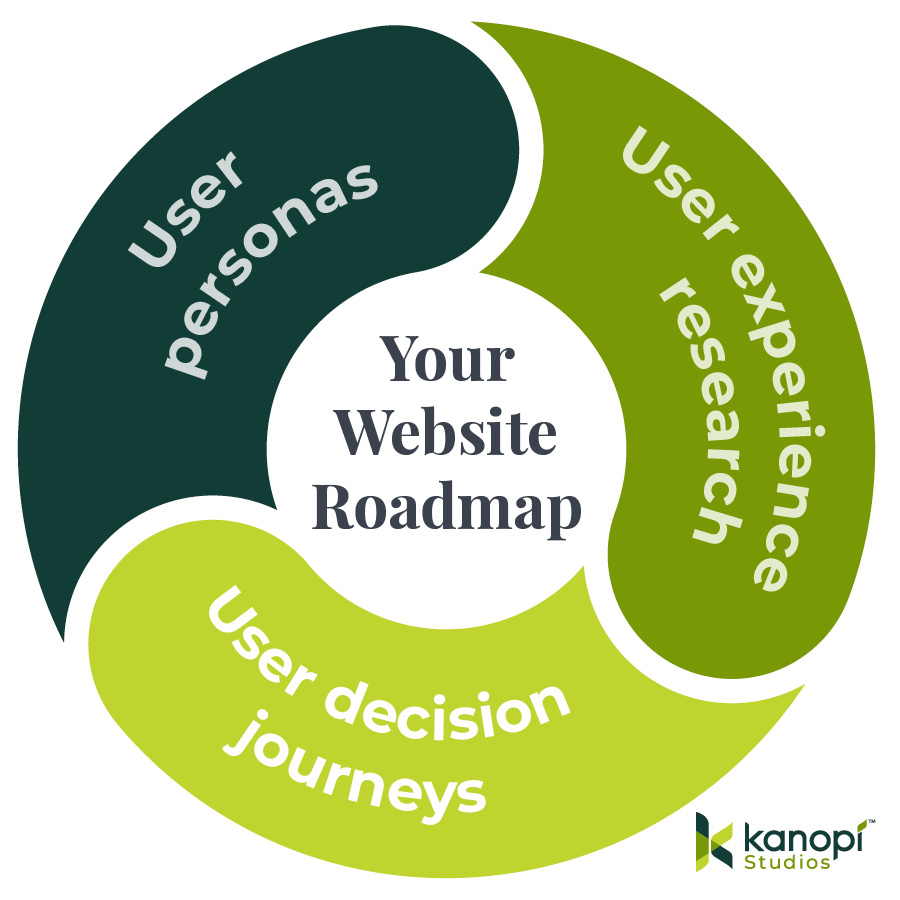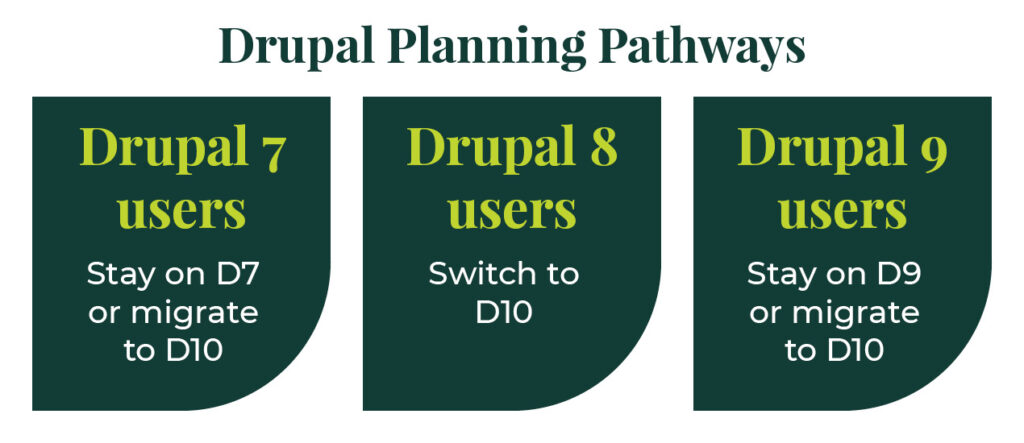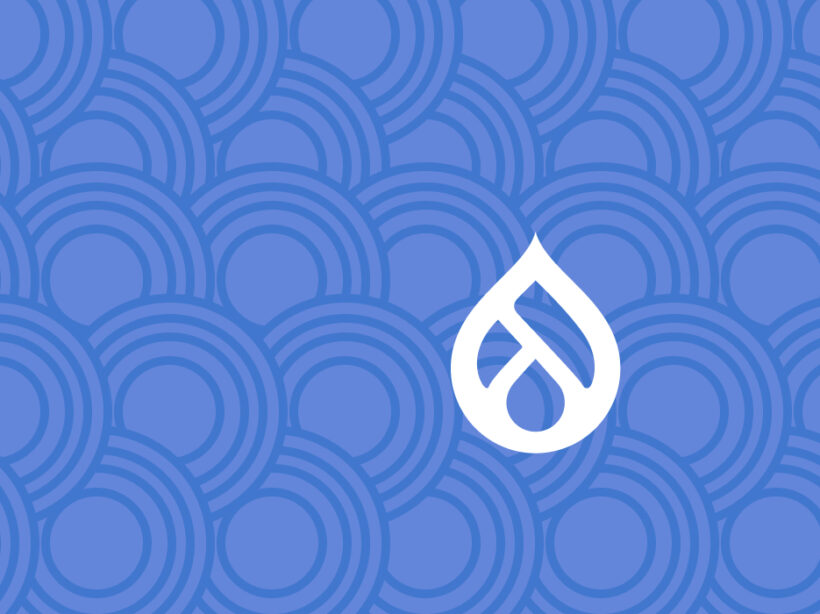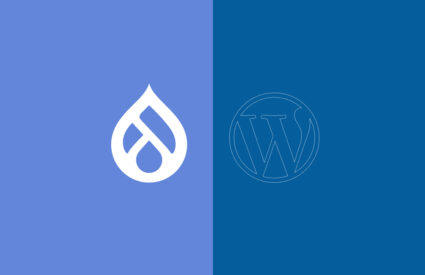This post was last updated in June 2023 to align with Drupal 7’s most recent end-of-life date of January 2025.
Kanopi is a certified Drupal migration partner and can help with your migration needs.
Drupal is an open-source software content management system (CMS) that powers over 1 million websites globally. As a Drupal user, you were probably drawn to the platform because of its scalability and flexibility. You also know your site requires continual planning and updates to remain an informative, engaging online presence.
To make sure your website continues to excel, you’ll also need to stay up-to-date with the latest changes in the Drupal world. Drupal launched its latest version—D10—in December 2022. In addition to this update, Drupal extended Drupal 7’s life to January 2025.
Now is a good time to review how these changes will impact your CMS planning. We’ve crafted this Drupal planning and development guide to help you prepare for migrations and preserve your website well into the future. Let’s get started by looking at some frequently asked questions from Drupal users regarding planning and development.
Drupal Planning and Development FAQs
What is the difference between WordPress and Drupal?
Both Drupal and WordPress are user-friendly, open-source platforms used to build powerful, comprehensive websites. Generally speaking, WordPress is known for its relatively simple admin user experience with many ready-made themes to choose from. By contrast, Drupal is often used by organizations looking to build complex sites, integrate with other services, and receive ongoing support from an agency or in-house developers.
If you’re looking to switch systems or are adopting a robust CMS for the first time, compare each platform’s features to determine which one better suits your needs. Kanopi’s Drupal vs. WordPress guide can help steer your decision-making.
I see Drupal 10 is the latest version. Should I upgrade to Drupal 10?
Upgrading your website to Drupal 10 all depends on your current codebase and whether you have the resources and time needed to manage a migration. An audit of your existing Drupal site can help you decide if D10 is the right choice for you.
Kanopi can help you work out the best migration path. We’ll take a deep dive into your Drupal planning and development roadmap later on in this post.
How often should I make security and module updates in Drupal?
Review Drupal core security updates and contributed modules as they are released and apply them with expedience based on their Security Risk level. The higher the level, the more risk the vulnerability is to the site.
Non-security module updates are best done monthly or quarterly depending on time available or budget. Keeping your code up to date with the latest releases helps make future site upgrades easier, takes advantage of bug fixes, and can add additional functionality.
How can I get started building my Drupal planning and development strategy?
If you’re unsure where to begin with your Drupal planning, consider partnering with a Drupal development specialist. We’ve compiled a list of key support tasks you should expect to receive from an agency offering to assist you with your Drupal planning. They should:
- Work with you to create a Drupal strategy roadmap.
- Get familiar with your organization and your budget.
- Define the best way to curate existing content to maximize conversions.
- Provide module support.
- Offer Drupal training.
We’ll highlight additional ways a Drupal specialist can help optimize your website later on in this post.
Where can I find Drupal talent?
Drupal.org is a great place to start if you’re looking for Drupal talent. Kanopi also has a friendly team of Drupal experts ready to help you strategize your Drupal planning and development. Each of our Drupal experts has an average of 11 years of experience in Drupal development.
Where can I find more Drupal development tools and resources?
Kanopi’s resource library can help you learn more about Drupal, stay up to date on release updates, and craft your development strategy. Drupal also has a dedicated Slack channel for users. Other resources include:
Preparing Your Drupal Planning and Development Roadmap
Have you reviewed your website users’ needs recently? What about your site’s usability, accessibility, and content quality?
User needs change over time. That’s why it’s essential to have the most up-to-date picture of your users’ unique needs and take steps to determine whether your website content meets those demands.
If you’re brainstorming your Drupal roadmap, we suggest carefully considering the following:

- Undertaking user experience (UX) research. Use your website analytics and traffic patterns to determine how effectively different website aspects engage visitors. For instance, does your nonprofit’s online donation form have a high conversion rate? Can visitors easily find your business’s contact information and event calendar? Test site elements such as load speed, mobile-friendliness, and accessibility.
- Streamlining your user decision journey. The user decision journey is the steps your audience members take to learn about your organization and determine whether they want to engage with you further. This might involve purchasing one of your products or services, donating to your cause, or signing up to become a member of your group. Assess whether your website streamlines the user journey by asking questions about how visitors are likely to engage with your site. Do you have a variety of calls to action throughout the site that encourage visitors to get more involved?
- Fine-tuning your user personas. Is your website reaching the right people? Creating in-depth audience profiles allows you to understand your audience’s needs, goals, and interests and design your website content accordingly. Reassess your user personas to determine whether your audience has changed. Use the information in your customer or constituent relationship management system to assess your audience’s demographics, purchasing habits, and other distinctive characteristics.
By assessing the UX and appealing to your user personas, you can deal with blockages in your customers’ decision journey and create a more valuable website experience. You can also identify any sweet spots where your site currently excels that could be built upon ahead of your site migration.
Planning Pathways for Drupal Users
Your upgrade and maintenance process will look different depending on what version of Drupal you’re currently using. In this section, we’ll explore the various options available to Drupal users who intend to stay on the Drupal system.

Exploring Drupal 10
As mentioned, Drupal 10 was released on December 14, 2022. This release date was pushed back from June 2022 to give the development community time to improve the CKEditor 5 migration path. The previous iteration, CKEditor 4, will reach its end-of-life at the end of 2023, so the CKEditor 5 is a complete rewrite.
The December release date allowed Drupal 10 to be released alongside Symfony 6.2 and PHP 8.2 to ensure users have access to the most robust, efficient code base available.
If you’re thinking about transitioning your Drupal site to D10, Drupal’s Project Lead Dries Buytaert has emphasized that the transition from Drupal 9 to 10 will be the easiest migration in Drupal’s history. Drupal 10 is not a complete system overhaul, and it’s backward-compatible with Drupal 9. Buytaert explains how it will work:
“New functionality for Drupal 10 is actually added to Drupal 9 releases. This means module developers can start adopting any new APIs right away.
Along the way, we deprecate old functionality but keep backwards compatibility. Once we are ready to release Drupal 10, we remove all deprecated code.
Removing deprecated code breaks backwards compatibility, but because module developers had a chance to stay up to date with API changes, the upgrade to Drupal 10 should be easy.”
So, how can you prepare for D10? No matter what Drupal version you’re currently using, we’ve got a planning and development roadmap for you.
Drupal Planning: 7 to 10
Drupal 7’s end-of-life date was adjusted to November 2023 because of the COVID-19 pandemic’s impact on many organizations’ budgets, meaning that this version will actually last longer than D8. Therefore, many D7 users have decided to stick with this version to give themselves more time to prepare for an eventual transition to a later version.
Although you can remain on D7 for a while longer, now is a great time to transition to D10. You can ensure your website is fully prepared for the eventual release of D10 and even plan a website redesign if your site needs one.
Your D7 to D10 migration roadmap should include the following tasks:
- Make a plan for content that can be retired from your site before moving to Drupal 10.
- Map out how redirects will be handled for any content that you are removing from the current site to ensure your SEO isn’t negatively affected.
- Review the modules you use in Drupal 7 and investigate the upgrade path needed for those modules to be compatible with Drupal 10.
- For modules that aren’t available for Drupal 10, identify and recommend alternative modules, tools, or third-party services.
- Look at content types on the site and determine if anything needs to be changed or combined to meet your users’ needs and/or make the site easier to maintain.
It’s recommended to switch to D10 before D7 reaches its end-of-life so you can continue benefiting from security team updates and fixes.
Sticking with Drupal 7
Your organization might want to stick with D7 for the time being to give yourself more time to gather the resources and funding needed to make the transition to D10.
Here are a few benefits of sticking with D7:
- Access to a large number of Drupal modules thanks to the open-source community
- Support from an entire community of Drupal professionals and developers
- Community developers who have been working with D7 for 11 years.
Use this time before you transition to a newer version of Drupal to prepare your website for the eventual switch. Keep your site healthy by implementing security updates as soon as possible. Audit your content to ensure it reflects your organization’s mission and appeals to your audience. If you have any outdated or extraneous content, remove it now so that you can launch your eventual website migration with only your strongest content.
Drupal Planning: 8 to 10
There’s good news and bad news for Drupal 8 users. Let’s start with the bad news: D8 reached its end-of-life in November 2021. Drupal 8 is no longer supported and no more bug fixes or improvements will be released, so if your site is currently running on D8, it’s more vulnerable to cyber-attacks and other security threats.
Here’s the good news: if you’re planning to migrate from D8 to 10, you are looking at a very simple, streamlined migration process.
Your Drupal development partners can create a roadmap with these elements:
- Look for any deprecated code in your D8 code base that may need to be updated for D10.
- Make sure that the modules you use in Drupal 8 are compatible with Drupal 10, or have a target date for compatibility.
- Ensure that the site’s configuration files are tidy so that it’s easy to export/import configuration during the upgrade.
Migrating your D8 site to D10 as soon as possible will put you in a good position to maintain your site’s security and functionality.
Drupal 9 Users
If you’re currently using D9, you’re in a great position to migrate to D10. Keep in mind that support for Drupal 9 will end in November 2023 as you make your development plan.
You can prepare for D10 by staying up-to-date with bug fixes and other security updates. If you have custom code on your site, keep an eye out for deprecation notices as well, and update that code regularly to remove them. Consider working with a web development consultant to help you stay on top of all updates. For instance, the Kanopi team offers website support services for all Drupal users. This includes:
- Module and plugin updates
- Bug fixes and security patches
- Performance enhancements
- Development modifications
Read on for a deeper look inside Kanopi’s Drupal development and support offerings.
Exploring Kanopi’s Drupal Planning and Development Services
Kanopi can support your Drupal site until it’s ready for an upgrade, even if that means going beyond the end-of-life date of your current operating version. Instead of large structural changes, we recommend focusing on incremental changes that can be delivered with a potentially fluctuating budget, such as:
- Improved navigation
- Revised content strategy
- New content curation
- Accessibility support
- Search engine optimization (SEO)
We can also provide a website growth plan for you, which typically includes:
- How to increase website conversions for your organization
- Customization based on your unique situation
- A breathing window to maintain your site ahead of a migration (if your site is operating on D7)
Along with our Drupal 7 maintenance package, we also have options for Drupal 8 and 9 users to help create a game plan or launch into a migration.
Looking for more information to learn more about Drupal planning and development? These additional Kanopi resources can help:
- Drupal 10 is Coming Soon. Here’s Everything You Should Know. Interested in learning more about Drupal 10’s release? Here’s what you need to know.
- Drupal 7 End of Life: A Guide to Next Steps. Are you considering which direction to take your Drupal 7 site next? This guide will help you figure out your next steps.
- Drupal 8 End-of-Life and Support: What’s Next? This guide offers everything Drupal 8 users need to know to transition to a new version successfully.









